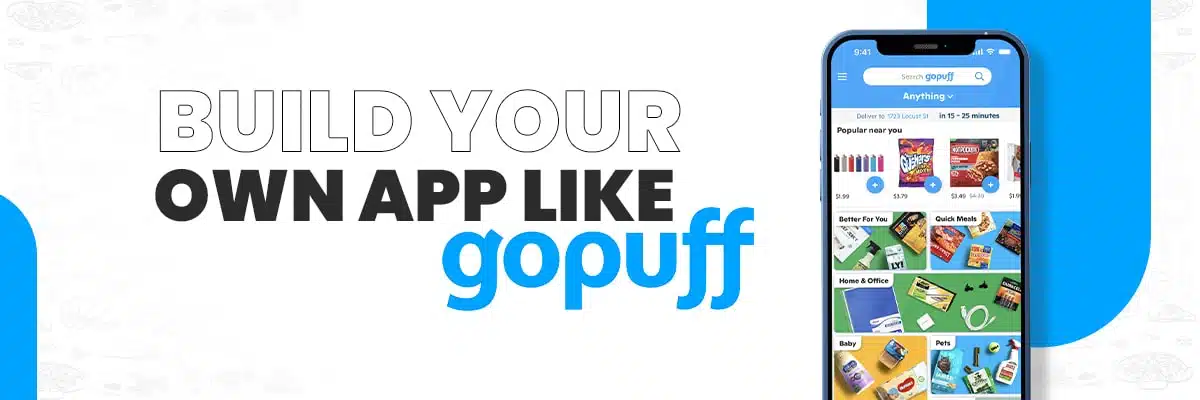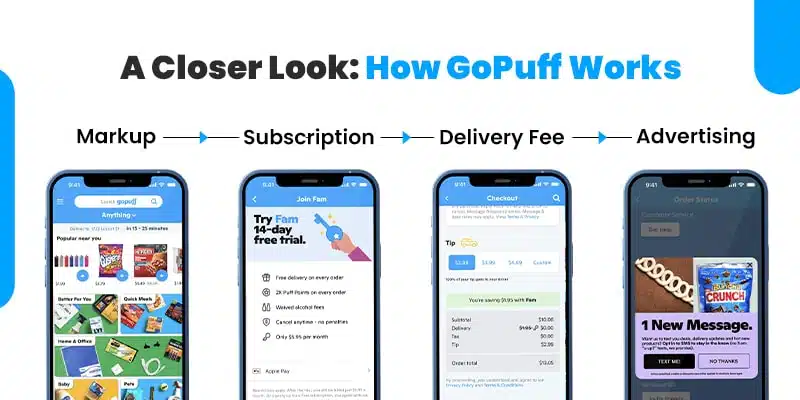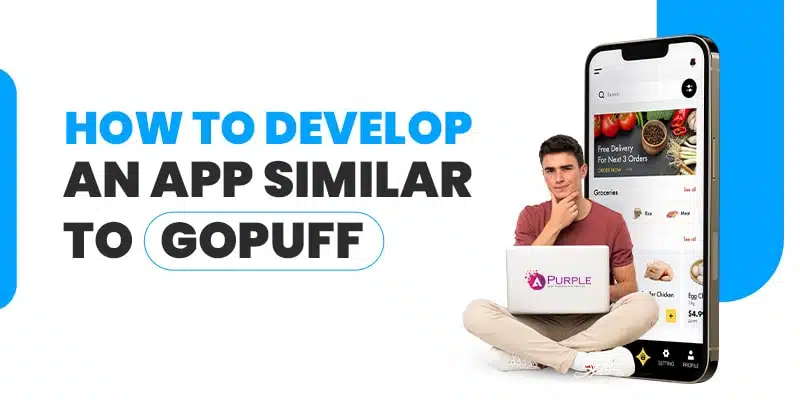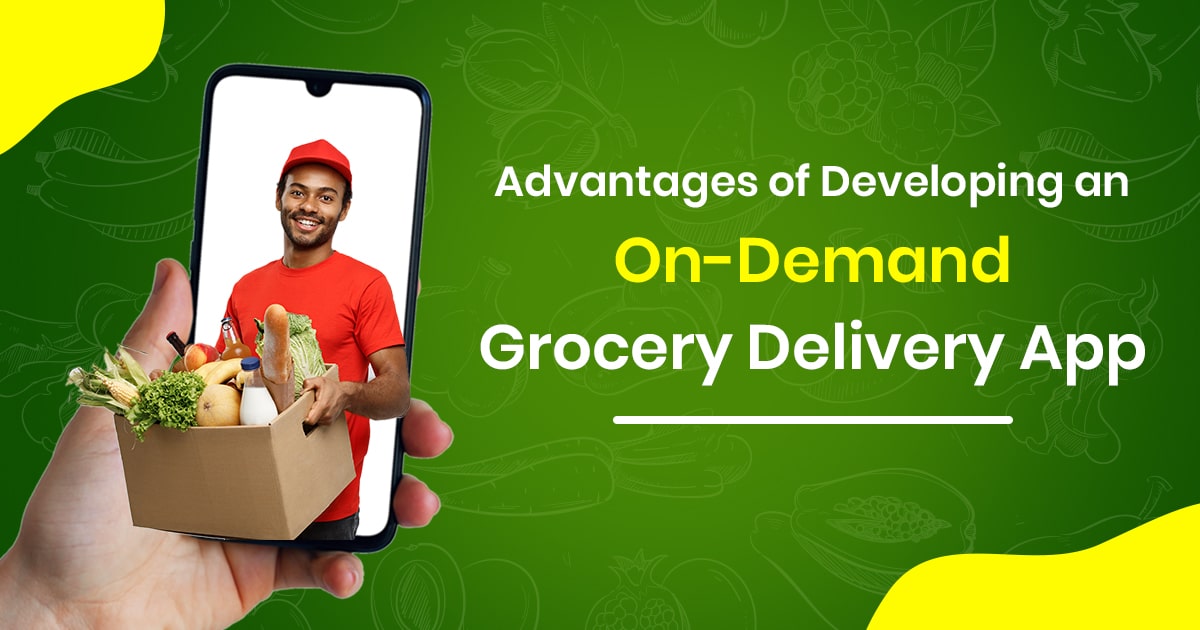
In the era of instant gratification, convenience isn’t a luxury – it’s the baseline expectation. We’ve moved beyond waiting for traditional grocery or restaurant delivery.
The modern challenge isn’t hunting, it’s getting exactly what you want, delivered now. All that’s required is a smartphone and a payment method. Instant delivery platforms have reshaped consumer habits for over two decades.
Need a snack, a last-minute household item, or even alcohol (where legal)? GoPuff figured out how to make that happen faster than almost anyone.
What exactly is GoPuff? How did they crack the code on ultra-fast delivery? And what are the core mechanics of their business model? Let’s break down the strategy behind this delivery giant.
What is GoPuff?
GoPuff is an on-demand delivery platform founded in 2013 by Rafael Ilishayev and Yakir Gola in Philadelphia. Unlike apps that deliver from existing stores, GoPuff operates a vertical integration model. They deliver a massive range of products—snacks, drinks, household essentials, OTC meds, and alcohol (in certain markets) – often 24/7.
It has scaled significantly, now serving over 1,000 cities across the US and parts of the UK. While its overall valuation has seen the typical fluctuations of the current tech market, its strategic shift to owning the inventory remains its competitive edge.
The key differentiator: GoPuff owns and stocks all products in its local warehouses, which they call micro-fulfillment centers. This model bypasses third-party store delays, enabling those lightning-fast delivery times, frequently in the 15–30 minutes. minute window.
To summarize GoPuff’s strategic advantages, here are the key features that define its service:
- Massive Product Range: They don’t just deliver; they stock thousands of SKUs—from impulse buys (snacks, alcohol) to high-necessity items (OTC medicine, baby/pet supplies).
- 24/7 Availability: Their micro-fulfillment centers operate around the clock, catering to demand when traditional retail is closed (e.g., late-night orders).
- Tech-Driven: They leverage custom AI/ML to optimize every stage—from inventory placement to driver routing. This focus on operational efficiency is reported to boost key metrics like click-through rates and conversion.
- Targeted Demographic: Their primary audience is Gen Z and millennials, a group known for valuing instant gratification, with the company reporting over 3 million active users recently.
Understanding these features leads to the next crucial question: How does GoPuff’s operating model translate into revenue and growth?
How does GoPuff Work? – A Must Know Thing
GoPuff’s core mechanism is built on vertical integration to control the entire customer experience. They are essentially a digital retailer with a hyper-local fulfillment network. By owning the inventory and operating their own micro-fulfillment centers, they cut out the middleman (a third-party store), ensuring quicker dispatch and easier inventory management.
Delivery is managed through a network of independent contract drivers who use a dedicated Driver App. This app is the hub for accepting orders, tracking routes, and managing customer communication efficiently.
Their pricing strategy is clear: a flat delivery fee (currently around $3.95) plus an additional regulatory fee (often another $3.95) for age-restricted products like alcohol or tobacco, which require extra ID verification.
To boost customer Lifetime Value (LTV), they push their subscription program, “Fam.” For a monthly fee (currently about $7.99), members get:
- Free delivery on all orders, driving higher purchase frequency.
- Exclusive benefits like “Puff Points” for redemption, further locking customers into the ecosystem.
You May Also Like: Grocery App Development
GoPuff’s 4-Pillar Revenue Model
- Retail Markup (The Core): By owning the inventory, they control the purchasing cost and the final selling price. The difference (the gross margin) is their primary source of profit.
- Subscription: The recurring revenue from the ‘Fam’ membership provides predictable income and significantly increases customer retention and average order value (AOV).
- Delivery & Regulatory Fees: Flat charges for non-members and the specific fee for regulated goods add to transactional revenue.
- Retail Media / Advertising: Brands pay to have their products featured prominently on the app (like digital shelf space), creating a high-margin revenue stream common in e-commerce.
GoPuff gained massive early traction by focusing on high-demand, high-margin categories like alcohol delivery—a challenging but highly lucrative niche. This service, once novel, is now a massive growth area, driving demand for specialized alcohol delivery app development. Consumers prioritize convenience over a trip to the store, and the market is responding.
By the year 2023, around 37.2% of the population will be using online food delivery services.
How to Build a GoPuff-Style Quick-Commerce Startup?
The quick-commerce (Q-Commerce) sector is still booming. GoPuff proved the micro-fulfillment model is viable, and with their revenue figures hitting the billions, the demand for 30-minute delivery is a proven market need. However, launching a competitor isn’t about simply building an app; it’s about solving complex operational logistics and achieving positive unit economics. If you’re ready to tackle this massive opportunity, here is the strategic roadmap, focusing on modern build-vs-buy decisions and AI integration.
Building the technology is the easy part. Building a scalable, profitable business is the challenge. Here are the core strategic components to focus on:
-
Achieve Hyper-Focused Product-Market Fit (PMF)
Don’t try to be all things to all people. Identify a specific, unmet need in a highly dense geographic area. Example: GoPuff started with convenience store items for college students. Your research must define the Niche, Geographic Cluster, and Core Product Set that drives your initial, profitable orders.
-
Product and User Experience (UX)
Your UX must be frictionless and fast. The concept of “app clone” is a high-risk strategy; while a template can save time, your core technology (inventory management, routing, fulfillment staff app) must be custom-built or integrated from specialist providers to handle the quick-commerce logistics. Focus on a clean design that allows users to transact in the fewest possible taps.
You May Also Like:UberEats clone app development
-
Optimized Inventory & Catalog Management
The catalog is your digital storefront, but unlike a marketplace, you own this inventory. Use a robust CMS that links directly to your warehouse stock in real-time. Crucial for profitability: Use AI to forecast demand by location to minimize waste and stockouts.
-
Seamless Checkout & Payment Flow
This is a trust and conversion point. Ensure integration with all major regional payment providers (credit/debit, digital wallets, local BNPL options). The checkout process must be one-click simple, with robust security protocols.
Advanced Logistics and Tracking Stack
The lifeblood of Q-Commerce. This requires three distinct components: Warehouse/Fulfillment Staff App, Driver App (with optimized routing/batching for efficiency), and Customer-facing Real-Time GPS Tracking. Use specialized tools for route optimization (like those leveraging Google Maps Platform) to reduce delivery time and driver costs.
-
Regulatory and High-Risk Compliance
One of the biggest challenges of building an on-demand delivery app like GoPuff Delivery is regulatory compliance. Ensure that your app complies with all relevant regulations and laws. This could be around food safety, data privacy, transportation, etc
One important aspect to consider when building an on-demand delivery app like GoPuff is competition from other established players in the market, such as Deliveroo and Uber Eats. These are big players. They have a large network of drivers and established partnerships with local restaurants. Surely, they’ll make it harder for new players to enter the market.
How AI Is Redefining GoPuff-like Apps with Personalization and Efficiency?
When you integrate AI into GoPuff-like delivery apps, it’s not just about adding smart tech — it’s about creating smoother, faster, and more personalized experiences for users. From predicting what customers want next to optimizing how deliveries happen in real time, AI turns everyday convenience into a competitive advantage.
-
Enhanced Personalization:
AI helps these apps understand customers on a personal level — from what they buy to when they usually order. Using this data, your app can automatically recommend snacks, drinks, or combos users are likely to enjoy. The result? A Netflix-style experience for delivery apps, where users feel the app truly “gets” them.
-
Improved Operational Efficiency:
Behind the scenes, AI ensures operations run like clockwork. It forecasts demand spikes (like snacks during game nights), manages inventory smartly, and helps drivers find the fastest routes. This means fewer delays, less wastage, and lower costs — all while delivering a better customer experience at scale.
-
Intelligent Customer Support:
No one likes waiting on hold. That’s why AI chatbots are transforming customer support. They handle most queries instantly — from order tracking to refunds — and escalate only complex issues to human agents. Using natural language understanding, these bots make customer interactions feel quick, natural, and stress-free.
You May Also Like: Milk Delivery App Development
How aPurple Can Help You Build a Smarter GoPuff-like App?
If you’re planning to launch an on-demand delivery app and want to integrate AI-driven intelligence, aPurple is your go-to partner. We specialize in building scalable, AI-enabled mobile apps that simplify user journeys and improve operational efficiency from day one.
Our team of experienced developers, designers, and product strategists collaborates closely with startups to build solutions that match their audience, budget, and goals. Every project has its own timeline and cost — but one thing remains constant: our commitment to delivering high-performing apps that drive real results.
With the right mix of technology, strategy, and team support, building a successful on-demand delivery app isn’t just possible — it’s profitable. If you’re ready to bring your idea to life, let’s collaborate and turn your vision into the next big name in instant delivery.





